Corporate & Financial Accounting: Regulations, Standards & Analysis
VerifiedAdded on 2023/06/05
|15
|3069
|216
Report
AI Summary
This report provides a comprehensive overview of corporate and financial accounting, focusing on the regulatory environment and the role of accounting standard bodies like IASB and AASB. It discusses the importance of financial regulation in ensuring transparency and accuracy in financial reporting. Furthermore, the report includes a detailed debt and equity analysis of four publicly listed Australian companies: ANZ Bank, Bank of Queensland, Macquarie Group, and AMP Bank. The analysis examines components of owner's equity, including ordinary share capital, preference share capital, retained earnings, and reserves, to assess the financial health and performance of these companies. Desklib provides access to this assignment along with other solved papers.
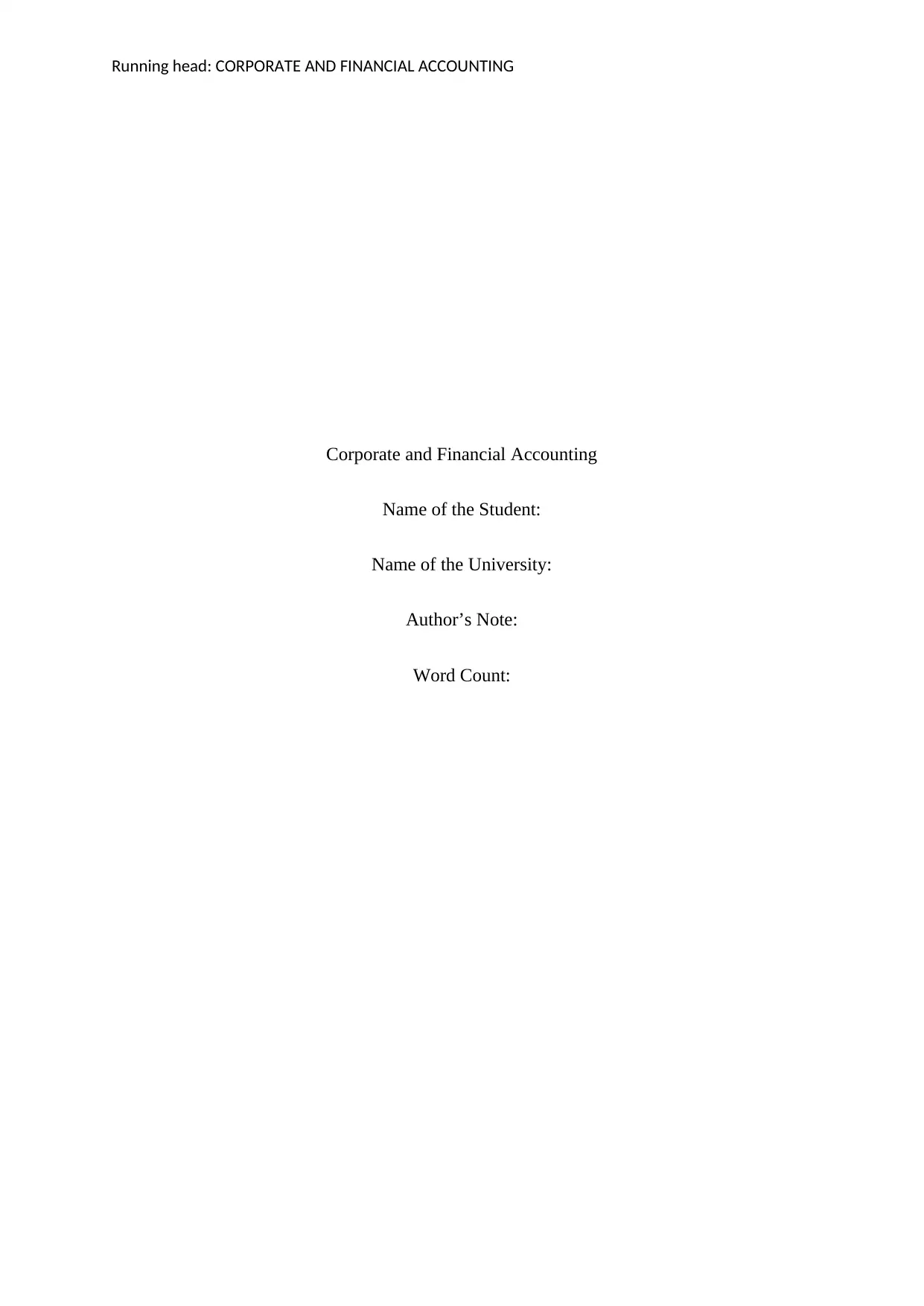
Running head: CORPORATE AND FINANCIAL ACCOUNTING
Corporate and Financial Accounting
Name of the Student:
Name of the University:
Author’s Note:
Word Count:
Corporate and Financial Accounting
Name of the Student:
Name of the University:
Author’s Note:
Word Count:
Paraphrase This Document
Need a fresh take? Get an instant paraphrase of this document with our AI Paraphraser
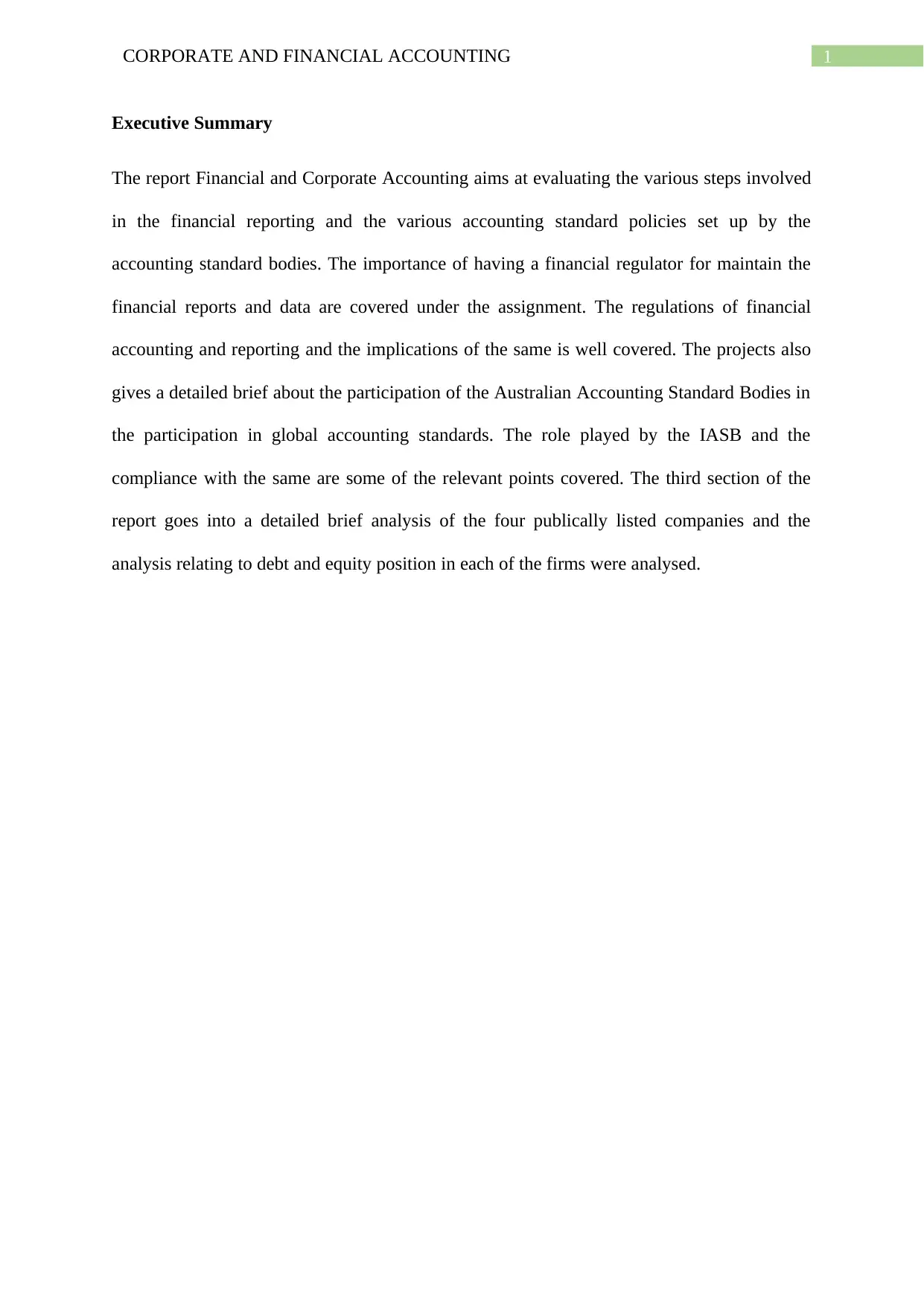
1CORPORATE AND FINANCIAL ACCOUNTING
Executive Summary
The report Financial and Corporate Accounting aims at evaluating the various steps involved
in the financial reporting and the various accounting standard policies set up by the
accounting standard bodies. The importance of having a financial regulator for maintain the
financial reports and data are covered under the assignment. The regulations of financial
accounting and reporting and the implications of the same is well covered. The projects also
gives a detailed brief about the participation of the Australian Accounting Standard Bodies in
the participation in global accounting standards. The role played by the IASB and the
compliance with the same are some of the relevant points covered. The third section of the
report goes into a detailed brief analysis of the four publically listed companies and the
analysis relating to debt and equity position in each of the firms were analysed.
Executive Summary
The report Financial and Corporate Accounting aims at evaluating the various steps involved
in the financial reporting and the various accounting standard policies set up by the
accounting standard bodies. The importance of having a financial regulator for maintain the
financial reports and data are covered under the assignment. The regulations of financial
accounting and reporting and the implications of the same is well covered. The projects also
gives a detailed brief about the participation of the Australian Accounting Standard Bodies in
the participation in global accounting standards. The role played by the IASB and the
compliance with the same are some of the relevant points covered. The third section of the
report goes into a detailed brief analysis of the four publically listed companies and the
analysis relating to debt and equity position in each of the firms were analysed.
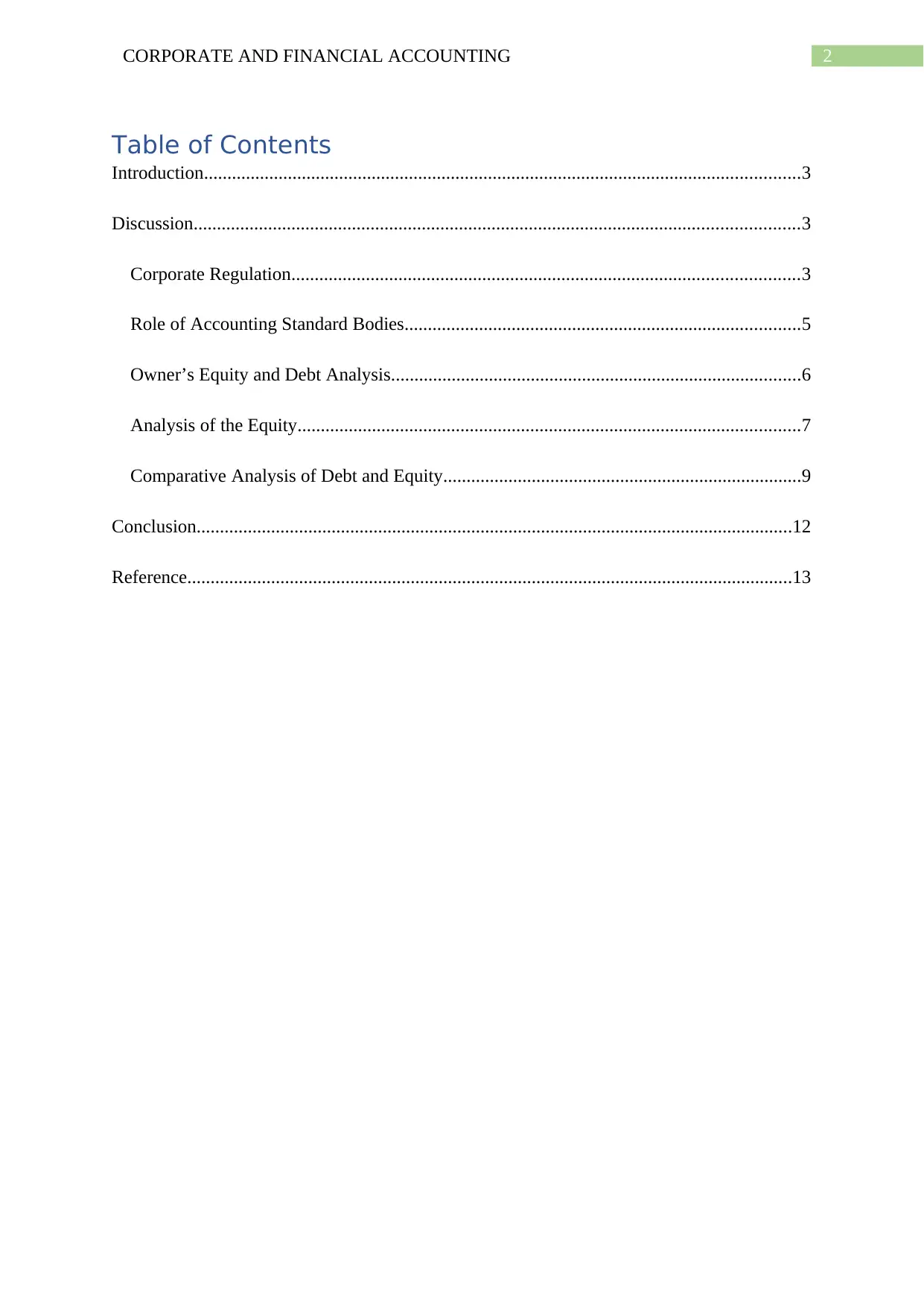
2CORPORATE AND FINANCIAL ACCOUNTING
Table of Contents
Introduction................................................................................................................................3
Discussion..................................................................................................................................3
Corporate Regulation.............................................................................................................3
Role of Accounting Standard Bodies.....................................................................................5
Owner’s Equity and Debt Analysis........................................................................................6
Analysis of the Equity............................................................................................................7
Comparative Analysis of Debt and Equity.............................................................................9
Conclusion................................................................................................................................12
Reference..................................................................................................................................13
Table of Contents
Introduction................................................................................................................................3
Discussion..................................................................................................................................3
Corporate Regulation.............................................................................................................3
Role of Accounting Standard Bodies.....................................................................................5
Owner’s Equity and Debt Analysis........................................................................................6
Analysis of the Equity............................................................................................................7
Comparative Analysis of Debt and Equity.............................................................................9
Conclusion................................................................................................................................12
Reference..................................................................................................................................13
⊘ This is a preview!⊘
Do you want full access?
Subscribe today to unlock all pages.

Trusted by 1+ million students worldwide
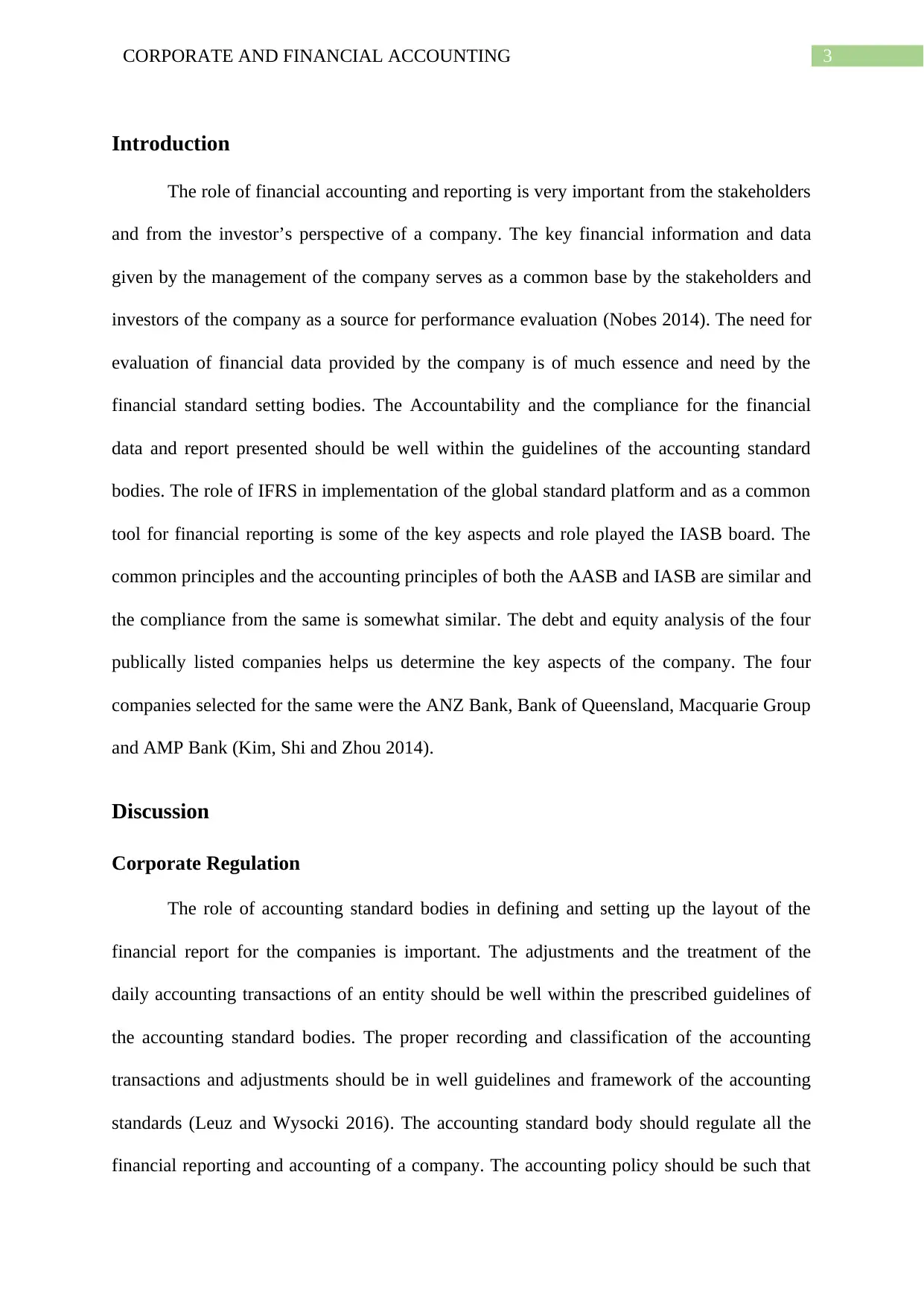
3CORPORATE AND FINANCIAL ACCOUNTING
Introduction
The role of financial accounting and reporting is very important from the stakeholders
and from the investor’s perspective of a company. The key financial information and data
given by the management of the company serves as a common base by the stakeholders and
investors of the company as a source for performance evaluation (Nobes 2014). The need for
evaluation of financial data provided by the company is of much essence and need by the
financial standard setting bodies. The Accountability and the compliance for the financial
data and report presented should be well within the guidelines of the accounting standard
bodies. The role of IFRS in implementation of the global standard platform and as a common
tool for financial reporting is some of the key aspects and role played the IASB board. The
common principles and the accounting principles of both the AASB and IASB are similar and
the compliance from the same is somewhat similar. The debt and equity analysis of the four
publically listed companies helps us determine the key aspects of the company. The four
companies selected for the same were the ANZ Bank, Bank of Queensland, Macquarie Group
and AMP Bank (Kim, Shi and Zhou 2014).
Discussion
Corporate Regulation
The role of accounting standard bodies in defining and setting up the layout of the
financial report for the companies is important. The adjustments and the treatment of the
daily accounting transactions of an entity should be well within the prescribed guidelines of
the accounting standard bodies. The proper recording and classification of the accounting
transactions and adjustments should be in well guidelines and framework of the accounting
standards (Leuz and Wysocki 2016). The accounting standard body should regulate all the
financial reporting and accounting of a company. The accounting policy should be such that
Introduction
The role of financial accounting and reporting is very important from the stakeholders
and from the investor’s perspective of a company. The key financial information and data
given by the management of the company serves as a common base by the stakeholders and
investors of the company as a source for performance evaluation (Nobes 2014). The need for
evaluation of financial data provided by the company is of much essence and need by the
financial standard setting bodies. The Accountability and the compliance for the financial
data and report presented should be well within the guidelines of the accounting standard
bodies. The role of IFRS in implementation of the global standard platform and as a common
tool for financial reporting is some of the key aspects and role played the IASB board. The
common principles and the accounting principles of both the AASB and IASB are similar and
the compliance from the same is somewhat similar. The debt and equity analysis of the four
publically listed companies helps us determine the key aspects of the company. The four
companies selected for the same were the ANZ Bank, Bank of Queensland, Macquarie Group
and AMP Bank (Kim, Shi and Zhou 2014).
Discussion
Corporate Regulation
The role of accounting standard bodies in defining and setting up the layout of the
financial report for the companies is important. The adjustments and the treatment of the
daily accounting transactions of an entity should be well within the prescribed guidelines of
the accounting standard bodies. The proper recording and classification of the accounting
transactions and adjustments should be in well guidelines and framework of the accounting
standards (Leuz and Wysocki 2016). The accounting standard body should regulate all the
financial reporting and accounting of a company. The accounting policy should be such that
Paraphrase This Document
Need a fresh take? Get an instant paraphrase of this document with our AI Paraphraser
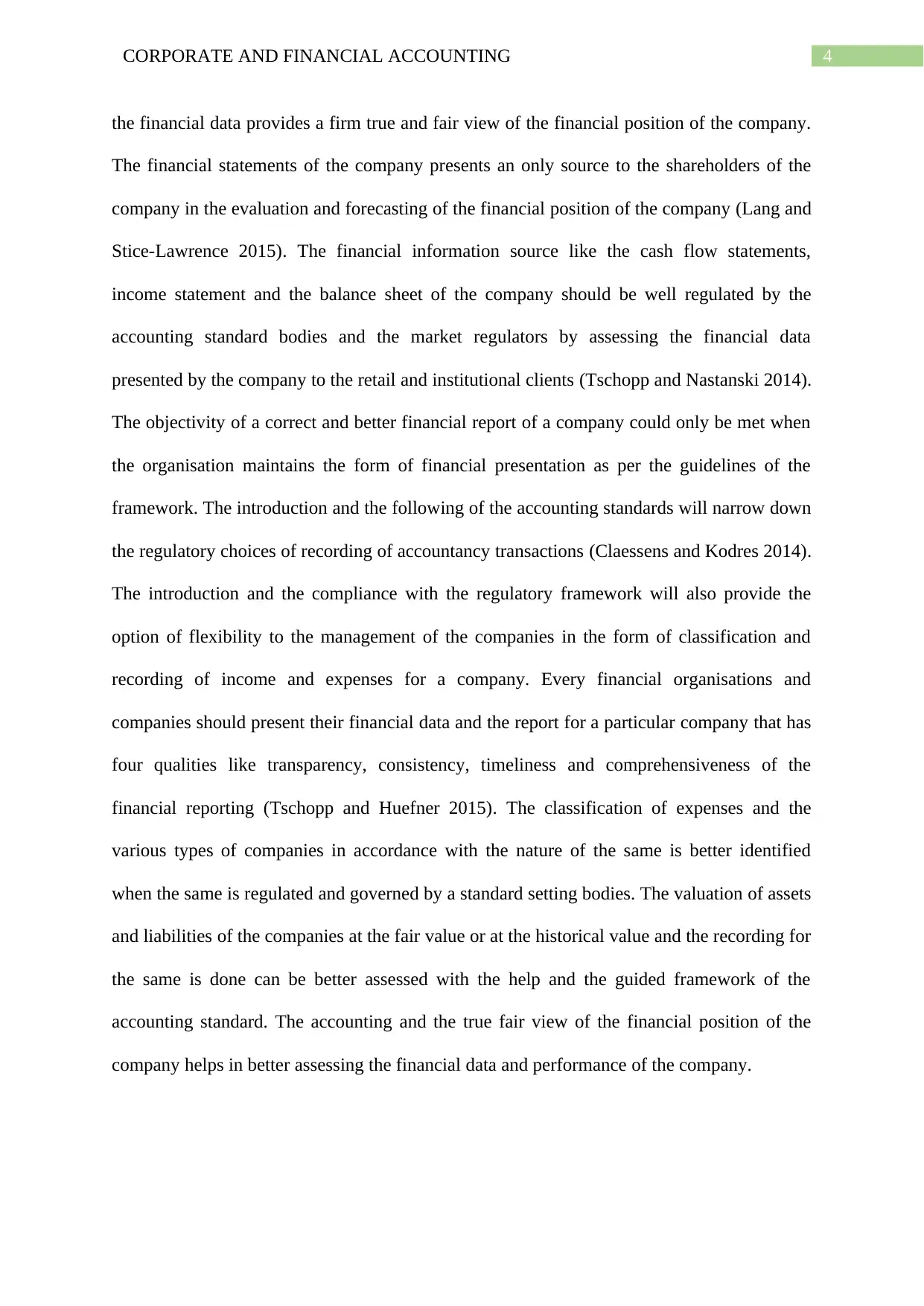
4CORPORATE AND FINANCIAL ACCOUNTING
the financial data provides a firm true and fair view of the financial position of the company.
The financial statements of the company presents an only source to the shareholders of the
company in the evaluation and forecasting of the financial position of the company (Lang and
Stice-Lawrence 2015). The financial information source like the cash flow statements,
income statement and the balance sheet of the company should be well regulated by the
accounting standard bodies and the market regulators by assessing the financial data
presented by the company to the retail and institutional clients (Tschopp and Nastanski 2014).
The objectivity of a correct and better financial report of a company could only be met when
the organisation maintains the form of financial presentation as per the guidelines of the
framework. The introduction and the following of the accounting standards will narrow down
the regulatory choices of recording of accountancy transactions (Claessens and Kodres 2014).
The introduction and the compliance with the regulatory framework will also provide the
option of flexibility to the management of the companies in the form of classification and
recording of income and expenses for a company. Every financial organisations and
companies should present their financial data and the report for a particular company that has
four qualities like transparency, consistency, timeliness and comprehensiveness of the
financial reporting (Tschopp and Huefner 2015). The classification of expenses and the
various types of companies in accordance with the nature of the same is better identified
when the same is regulated and governed by a standard setting bodies. The valuation of assets
and liabilities of the companies at the fair value or at the historical value and the recording for
the same is done can be better assessed with the help and the guided framework of the
accounting standard. The accounting and the true fair view of the financial position of the
company helps in better assessing the financial data and performance of the company.
the financial data provides a firm true and fair view of the financial position of the company.
The financial statements of the company presents an only source to the shareholders of the
company in the evaluation and forecasting of the financial position of the company (Lang and
Stice-Lawrence 2015). The financial information source like the cash flow statements,
income statement and the balance sheet of the company should be well regulated by the
accounting standard bodies and the market regulators by assessing the financial data
presented by the company to the retail and institutional clients (Tschopp and Nastanski 2014).
The objectivity of a correct and better financial report of a company could only be met when
the organisation maintains the form of financial presentation as per the guidelines of the
framework. The introduction and the following of the accounting standards will narrow down
the regulatory choices of recording of accountancy transactions (Claessens and Kodres 2014).
The introduction and the compliance with the regulatory framework will also provide the
option of flexibility to the management of the companies in the form of classification and
recording of income and expenses for a company. Every financial organisations and
companies should present their financial data and the report for a particular company that has
four qualities like transparency, consistency, timeliness and comprehensiveness of the
financial reporting (Tschopp and Huefner 2015). The classification of expenses and the
various types of companies in accordance with the nature of the same is better identified
when the same is regulated and governed by a standard setting bodies. The valuation of assets
and liabilities of the companies at the fair value or at the historical value and the recording for
the same is done can be better assessed with the help and the guided framework of the
accounting standard. The accounting and the true fair view of the financial position of the
company helps in better assessing the financial data and performance of the company.
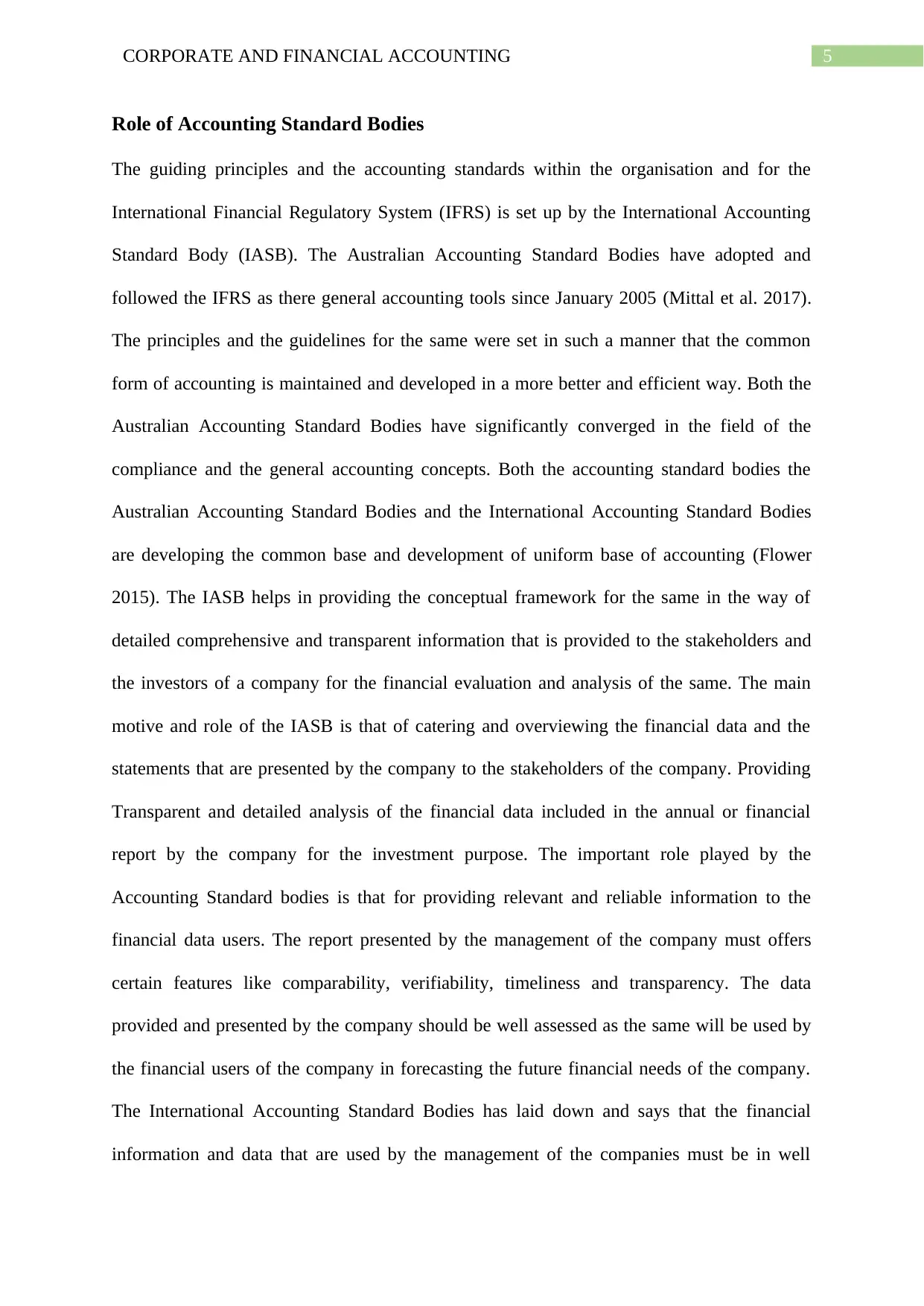
5CORPORATE AND FINANCIAL ACCOUNTING
Role of Accounting Standard Bodies
The guiding principles and the accounting standards within the organisation and for the
International Financial Regulatory System (IFRS) is set up by the International Accounting
Standard Body (IASB). The Australian Accounting Standard Bodies have adopted and
followed the IFRS as there general accounting tools since January 2005 (Mittal et al. 2017).
The principles and the guidelines for the same were set in such a manner that the common
form of accounting is maintained and developed in a more better and efficient way. Both the
Australian Accounting Standard Bodies have significantly converged in the field of the
compliance and the general accounting concepts. Both the accounting standard bodies the
Australian Accounting Standard Bodies and the International Accounting Standard Bodies
are developing the common base and development of uniform base of accounting (Flower
2015). The IASB helps in providing the conceptual framework for the same in the way of
detailed comprehensive and transparent information that is provided to the stakeholders and
the investors of a company for the financial evaluation and analysis of the same. The main
motive and role of the IASB is that of catering and overviewing the financial data and the
statements that are presented by the company to the stakeholders of the company. Providing
Transparent and detailed analysis of the financial data included in the annual or financial
report by the company for the investment purpose. The important role played by the
Accounting Standard bodies is that for providing relevant and reliable information to the
financial data users. The report presented by the management of the company must offers
certain features like comparability, verifiability, timeliness and transparency. The data
provided and presented by the company should be well assessed as the same will be used by
the financial users of the company in forecasting the future financial needs of the company.
The International Accounting Standard Bodies has laid down and says that the financial
information and data that are used by the management of the companies must be in well
Role of Accounting Standard Bodies
The guiding principles and the accounting standards within the organisation and for the
International Financial Regulatory System (IFRS) is set up by the International Accounting
Standard Body (IASB). The Australian Accounting Standard Bodies have adopted and
followed the IFRS as there general accounting tools since January 2005 (Mittal et al. 2017).
The principles and the guidelines for the same were set in such a manner that the common
form of accounting is maintained and developed in a more better and efficient way. Both the
Australian Accounting Standard Bodies have significantly converged in the field of the
compliance and the general accounting concepts. Both the accounting standard bodies the
Australian Accounting Standard Bodies and the International Accounting Standard Bodies
are developing the common base and development of uniform base of accounting (Flower
2015). The IASB helps in providing the conceptual framework for the same in the way of
detailed comprehensive and transparent information that is provided to the stakeholders and
the investors of a company for the financial evaluation and analysis of the same. The main
motive and role of the IASB is that of catering and overviewing the financial data and the
statements that are presented by the company to the stakeholders of the company. Providing
Transparent and detailed analysis of the financial data included in the annual or financial
report by the company for the investment purpose. The important role played by the
Accounting Standard bodies is that for providing relevant and reliable information to the
financial data users. The report presented by the management of the company must offers
certain features like comparability, verifiability, timeliness and transparency. The data
provided and presented by the company should be well assessed as the same will be used by
the financial users of the company in forecasting the future financial needs of the company.
The International Accounting Standard Bodies has laid down and says that the financial
information and data that are used by the management of the companies must be in well
⊘ This is a preview!⊘
Do you want full access?
Subscribe today to unlock all pages.

Trusted by 1+ million students worldwide
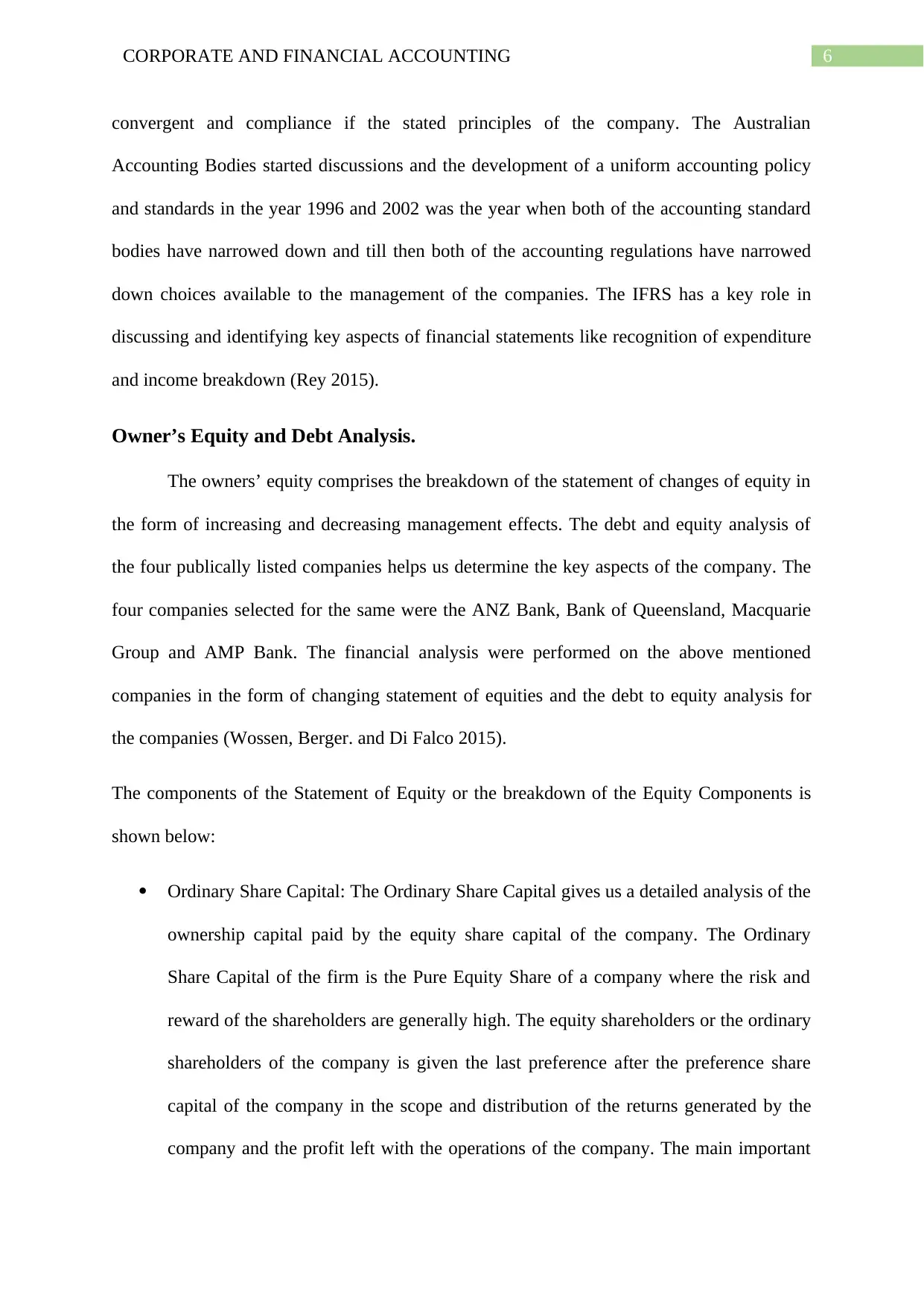
6CORPORATE AND FINANCIAL ACCOUNTING
convergent and compliance if the stated principles of the company. The Australian
Accounting Bodies started discussions and the development of a uniform accounting policy
and standards in the year 1996 and 2002 was the year when both of the accounting standard
bodies have narrowed down and till then both of the accounting regulations have narrowed
down choices available to the management of the companies. The IFRS has a key role in
discussing and identifying key aspects of financial statements like recognition of expenditure
and income breakdown (Rey 2015).
Owner’s Equity and Debt Analysis.
The owners’ equity comprises the breakdown of the statement of changes of equity in
the form of increasing and decreasing management effects. The debt and equity analysis of
the four publically listed companies helps us determine the key aspects of the company. The
four companies selected for the same were the ANZ Bank, Bank of Queensland, Macquarie
Group and AMP Bank. The financial analysis were performed on the above mentioned
companies in the form of changing statement of equities and the debt to equity analysis for
the companies (Wossen, Berger. and Di Falco 2015).
The components of the Statement of Equity or the breakdown of the Equity Components is
shown below:
Ordinary Share Capital: The Ordinary Share Capital gives us a detailed analysis of the
ownership capital paid by the equity share capital of the company. The Ordinary
Share Capital of the firm is the Pure Equity Share of a company where the risk and
reward of the shareholders are generally high. The equity shareholders or the ordinary
shareholders of the company is given the last preference after the preference share
capital of the company in the scope and distribution of the returns generated by the
company and the profit left with the operations of the company. The main important
convergent and compliance if the stated principles of the company. The Australian
Accounting Bodies started discussions and the development of a uniform accounting policy
and standards in the year 1996 and 2002 was the year when both of the accounting standard
bodies have narrowed down and till then both of the accounting regulations have narrowed
down choices available to the management of the companies. The IFRS has a key role in
discussing and identifying key aspects of financial statements like recognition of expenditure
and income breakdown (Rey 2015).
Owner’s Equity and Debt Analysis.
The owners’ equity comprises the breakdown of the statement of changes of equity in
the form of increasing and decreasing management effects. The debt and equity analysis of
the four publically listed companies helps us determine the key aspects of the company. The
four companies selected for the same were the ANZ Bank, Bank of Queensland, Macquarie
Group and AMP Bank. The financial analysis were performed on the above mentioned
companies in the form of changing statement of equities and the debt to equity analysis for
the companies (Wossen, Berger. and Di Falco 2015).
The components of the Statement of Equity or the breakdown of the Equity Components is
shown below:
Ordinary Share Capital: The Ordinary Share Capital gives us a detailed analysis of the
ownership capital paid by the equity share capital of the company. The Ordinary
Share Capital of the firm is the Pure Equity Share of a company where the risk and
reward of the shareholders are generally high. The equity shareholders or the ordinary
shareholders of the company is given the last preference after the preference share
capital of the company in the scope and distribution of the returns generated by the
company and the profit left with the operations of the company. The main important
Paraphrase This Document
Need a fresh take? Get an instant paraphrase of this document with our AI Paraphraser
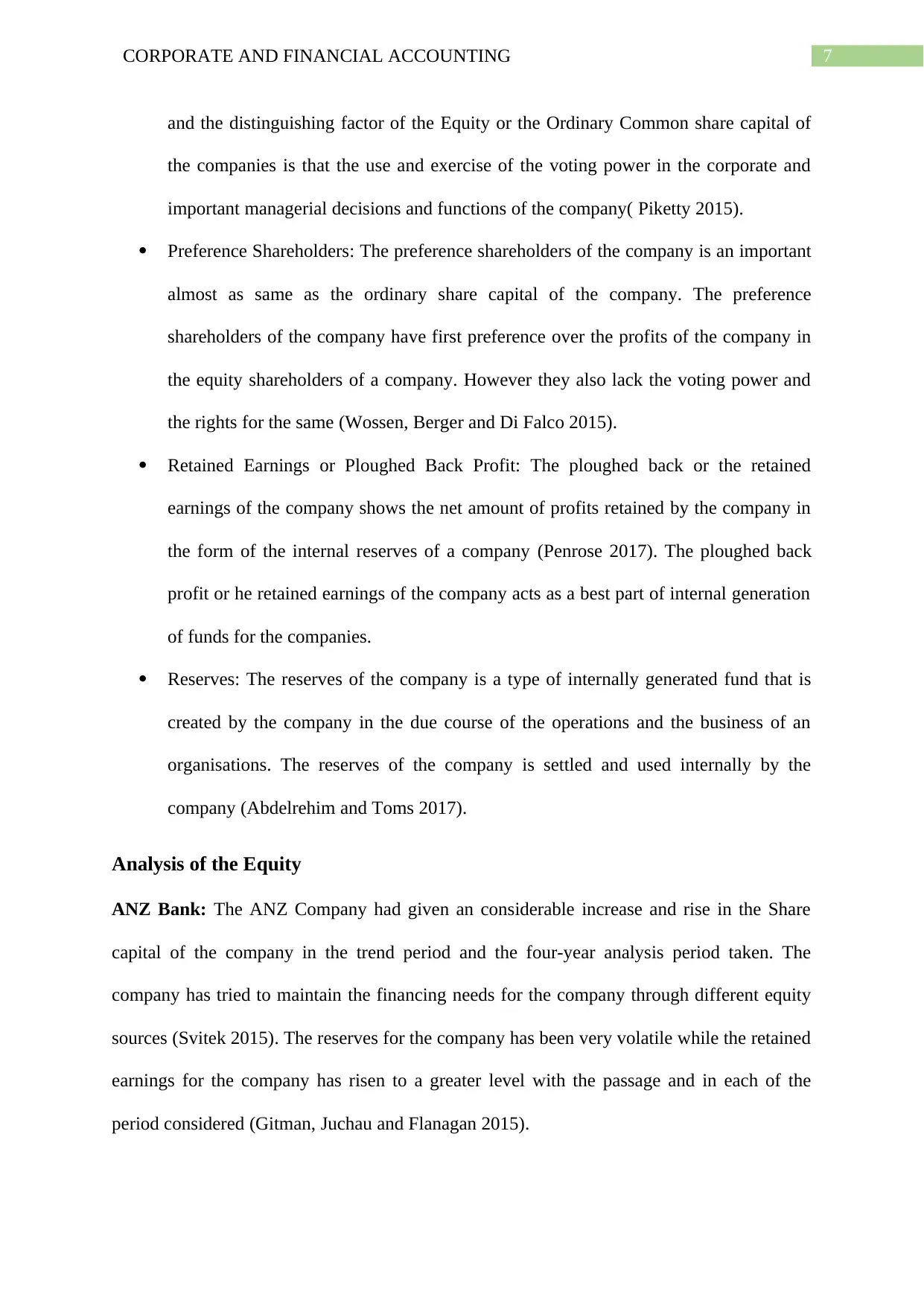
7CORPORATE AND FINANCIAL ACCOUNTING
and the distinguishing factor of the Equity or the Ordinary Common share capital of
the companies is that the use and exercise of the voting power in the corporate and
important managerial decisions and functions of the company( Piketty 2015).
Preference Shareholders: The preference shareholders of the company is an important
almost as same as the ordinary share capital of the company. The preference
shareholders of the company have first preference over the profits of the company in
the equity shareholders of a company. However they also lack the voting power and
the rights for the same (Wossen, Berger and Di Falco 2015).
Retained Earnings or Ploughed Back Profit: The ploughed back or the retained
earnings of the company shows the net amount of profits retained by the company in
the form of the internal reserves of a company (Penrose 2017). The ploughed back
profit or he retained earnings of the company acts as a best part of internal generation
of funds for the companies.
Reserves: The reserves of the company is a type of internally generated fund that is
created by the company in the due course of the operations and the business of an
organisations. The reserves of the company is settled and used internally by the
company (Abdelrehim and Toms 2017).
Analysis of the Equity
ANZ Bank: The ANZ Company had given an considerable increase and rise in the Share
capital of the company in the trend period and the four-year analysis period taken. The
company has tried to maintain the financing needs for the company through different equity
sources (Svitek 2015). The reserves for the company has been very volatile while the retained
earnings for the company has risen to a greater level with the passage and in each of the
period considered (Gitman, Juchau and Flanagan 2015).
and the distinguishing factor of the Equity or the Ordinary Common share capital of
the companies is that the use and exercise of the voting power in the corporate and
important managerial decisions and functions of the company( Piketty 2015).
Preference Shareholders: The preference shareholders of the company is an important
almost as same as the ordinary share capital of the company. The preference
shareholders of the company have first preference over the profits of the company in
the equity shareholders of a company. However they also lack the voting power and
the rights for the same (Wossen, Berger and Di Falco 2015).
Retained Earnings or Ploughed Back Profit: The ploughed back or the retained
earnings of the company shows the net amount of profits retained by the company in
the form of the internal reserves of a company (Penrose 2017). The ploughed back
profit or he retained earnings of the company acts as a best part of internal generation
of funds for the companies.
Reserves: The reserves of the company is a type of internally generated fund that is
created by the company in the due course of the operations and the business of an
organisations. The reserves of the company is settled and used internally by the
company (Abdelrehim and Toms 2017).
Analysis of the Equity
ANZ Bank: The ANZ Company had given an considerable increase and rise in the Share
capital of the company in the trend period and the four-year analysis period taken. The
company has tried to maintain the financing needs for the company through different equity
sources (Svitek 2015). The reserves for the company has been very volatile while the retained
earnings for the company has risen to a greater level with the passage and in each of the
period considered (Gitman, Juchau and Flanagan 2015).
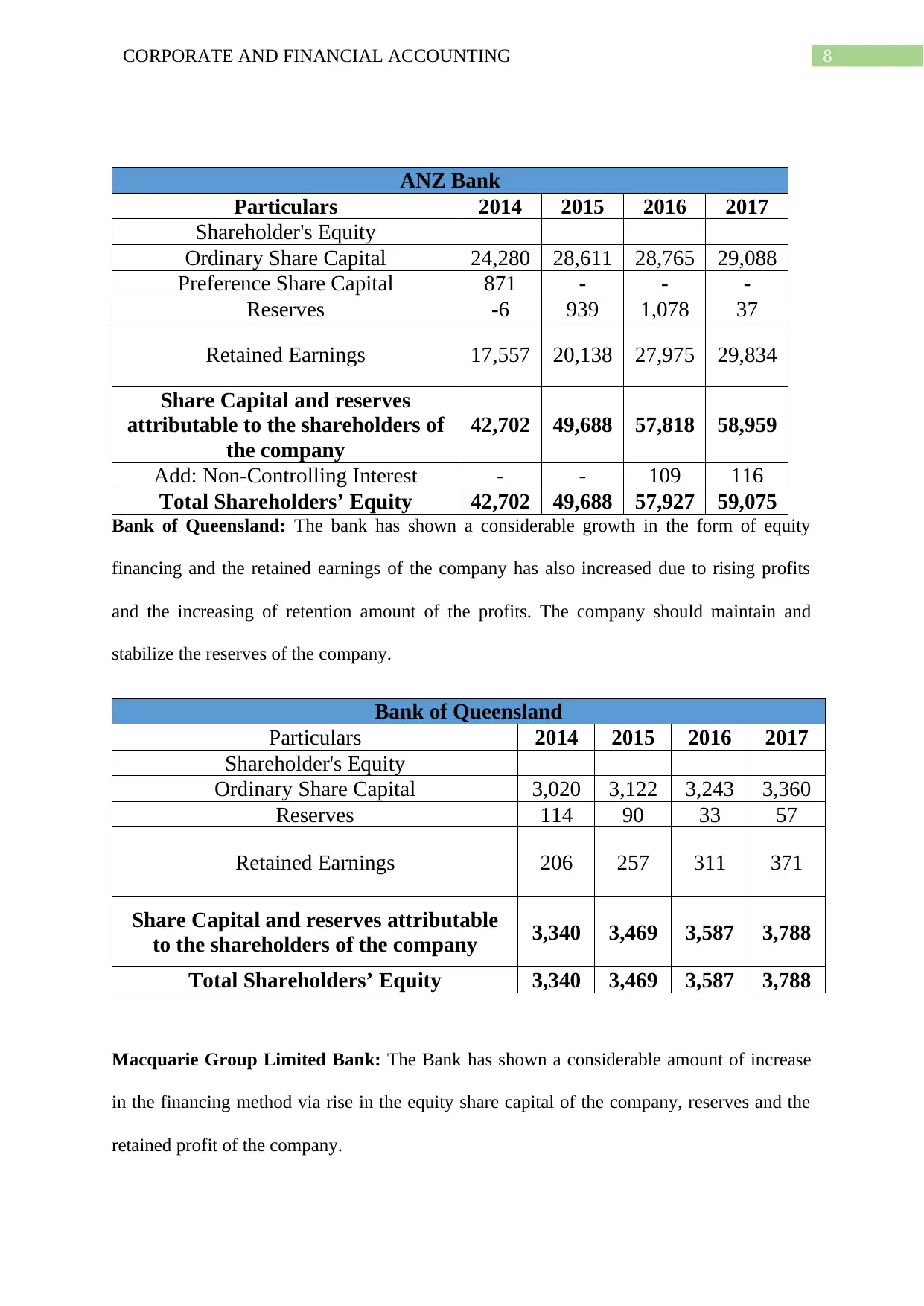
8CORPORATE AND FINANCIAL ACCOUNTING
ANZ Bank
Particulars 2014 2015 2016 2017
Shareholder's Equity
Ordinary Share Capital 24,280 28,611 28,765 29,088
Preference Share Capital 871 - - -
Reserves -6 939 1,078 37
Retained Earnings 17,557 20,138 27,975 29,834
Share Capital and reserves
attributable to the shareholders of
the company
42,702 49,688 57,818 58,959
Add: Non-Controlling Interest - - 109 116
Total Shareholders’ Equity 42,702 49,688 57,927 59,075
Bank of Queensland: The bank has shown a considerable growth in the form of equity
financing and the retained earnings of the company has also increased due to rising profits
and the increasing of retention amount of the profits. The company should maintain and
stabilize the reserves of the company.
Bank of Queensland
Particulars 2014 2015 2016 2017
Shareholder's Equity
Ordinary Share Capital 3,020 3,122 3,243 3,360
Reserves 114 90 33 57
Retained Earnings 206 257 311 371
Share Capital and reserves attributable
to the shareholders of the company 3,340 3,469 3,587 3,788
Total Shareholders’ Equity 3,340 3,469 3,587 3,788
Macquarie Group Limited Bank: The Bank has shown a considerable amount of increase
in the financing method via rise in the equity share capital of the company, reserves and the
retained profit of the company.
ANZ Bank
Particulars 2014 2015 2016 2017
Shareholder's Equity
Ordinary Share Capital 24,280 28,611 28,765 29,088
Preference Share Capital 871 - - -
Reserves -6 939 1,078 37
Retained Earnings 17,557 20,138 27,975 29,834
Share Capital and reserves
attributable to the shareholders of
the company
42,702 49,688 57,818 58,959
Add: Non-Controlling Interest - - 109 116
Total Shareholders’ Equity 42,702 49,688 57,927 59,075
Bank of Queensland: The bank has shown a considerable growth in the form of equity
financing and the retained earnings of the company has also increased due to rising profits
and the increasing of retention amount of the profits. The company should maintain and
stabilize the reserves of the company.
Bank of Queensland
Particulars 2014 2015 2016 2017
Shareholder's Equity
Ordinary Share Capital 3,020 3,122 3,243 3,360
Reserves 114 90 33 57
Retained Earnings 206 257 311 371
Share Capital and reserves attributable
to the shareholders of the company 3,340 3,469 3,587 3,788
Total Shareholders’ Equity 3,340 3,469 3,587 3,788
Macquarie Group Limited Bank: The Bank has shown a considerable amount of increase
in the financing method via rise in the equity share capital of the company, reserves and the
retained profit of the company.
⊘ This is a preview!⊘
Do you want full access?
Subscribe today to unlock all pages.

Trusted by 1+ million students worldwide
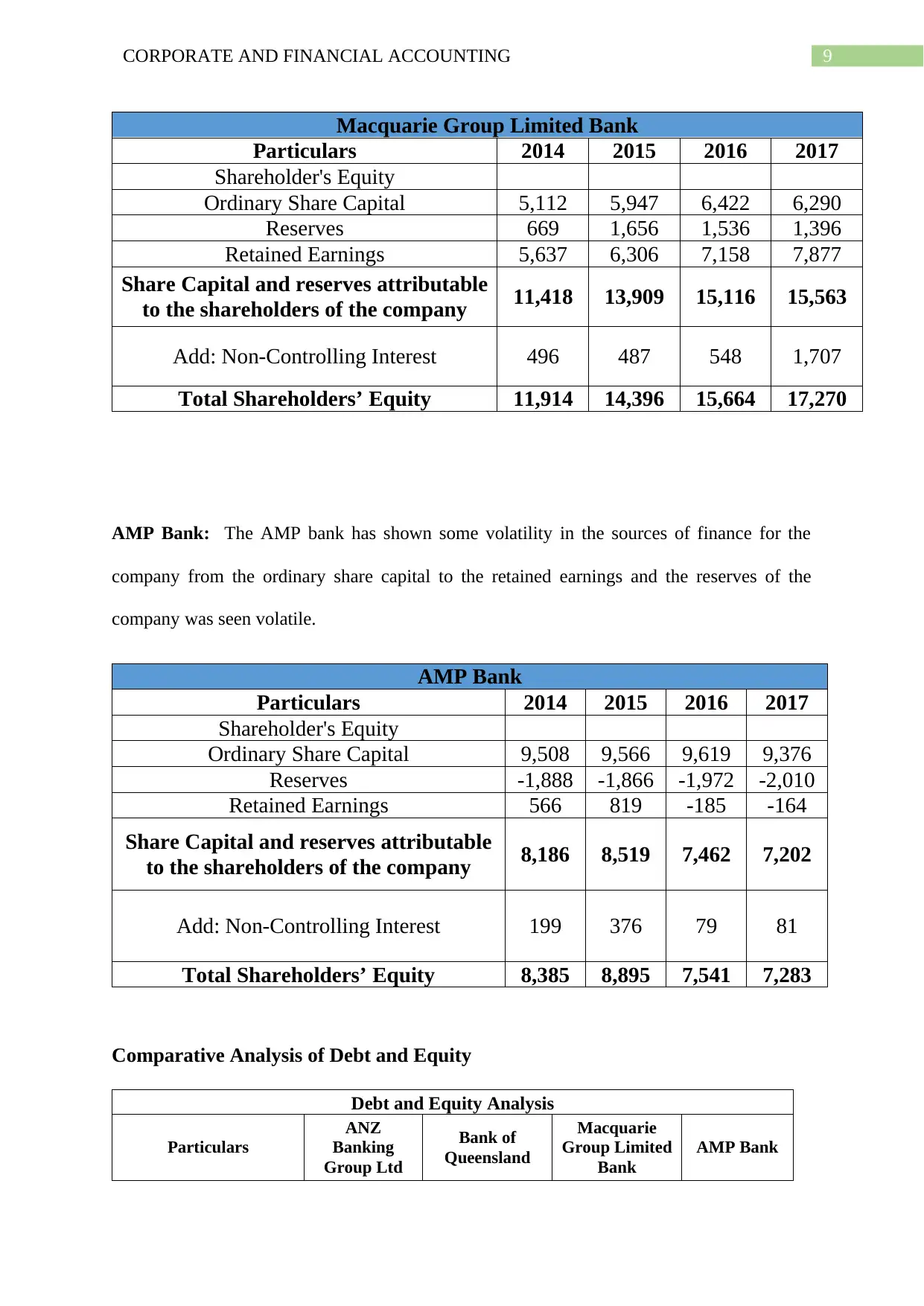
9CORPORATE AND FINANCIAL ACCOUNTING
Macquarie Group Limited Bank
Particulars 2014 2015 2016 2017
Shareholder's Equity
Ordinary Share Capital 5,112 5,947 6,422 6,290
Reserves 669 1,656 1,536 1,396
Retained Earnings 5,637 6,306 7,158 7,877
Share Capital and reserves attributable
to the shareholders of the company 11,418 13,909 15,116 15,563
Add: Non-Controlling Interest 496 487 548 1,707
Total Shareholders’ Equity 11,914 14,396 15,664 17,270
AMP Bank: The AMP bank has shown some volatility in the sources of finance for the
company from the ordinary share capital to the retained earnings and the reserves of the
company was seen volatile.
AMP Bank
Particulars 2014 2015 2016 2017
Shareholder's Equity
Ordinary Share Capital 9,508 9,566 9,619 9,376
Reserves -1,888 -1,866 -1,972 -2,010
Retained Earnings 566 819 -185 -164
Share Capital and reserves attributable
to the shareholders of the company 8,186 8,519 7,462 7,202
Add: Non-Controlling Interest 199 376 79 81
Total Shareholders’ Equity 8,385 8,895 7,541 7,283
Comparative Analysis of Debt and Equity
Debt and Equity Analysis
Particulars
ANZ
Banking
Group Ltd
Bank of
Queensland
Macquarie
Group Limited
Bank
AMP Bank
Macquarie Group Limited Bank
Particulars 2014 2015 2016 2017
Shareholder's Equity
Ordinary Share Capital 5,112 5,947 6,422 6,290
Reserves 669 1,656 1,536 1,396
Retained Earnings 5,637 6,306 7,158 7,877
Share Capital and reserves attributable
to the shareholders of the company 11,418 13,909 15,116 15,563
Add: Non-Controlling Interest 496 487 548 1,707
Total Shareholders’ Equity 11,914 14,396 15,664 17,270
AMP Bank: The AMP bank has shown some volatility in the sources of finance for the
company from the ordinary share capital to the retained earnings and the reserves of the
company was seen volatile.
AMP Bank
Particulars 2014 2015 2016 2017
Shareholder's Equity
Ordinary Share Capital 9,508 9,566 9,619 9,376
Reserves -1,888 -1,866 -1,972 -2,010
Retained Earnings 566 819 -185 -164
Share Capital and reserves attributable
to the shareholders of the company 8,186 8,519 7,462 7,202
Add: Non-Controlling Interest 199 376 79 81
Total Shareholders’ Equity 8,385 8,895 7,541 7,283
Comparative Analysis of Debt and Equity
Debt and Equity Analysis
Particulars
ANZ
Banking
Group Ltd
Bank of
Queensland
Macquarie
Group Limited
Bank
AMP Bank
Paraphrase This Document
Need a fresh take? Get an instant paraphrase of this document with our AI Paraphraser
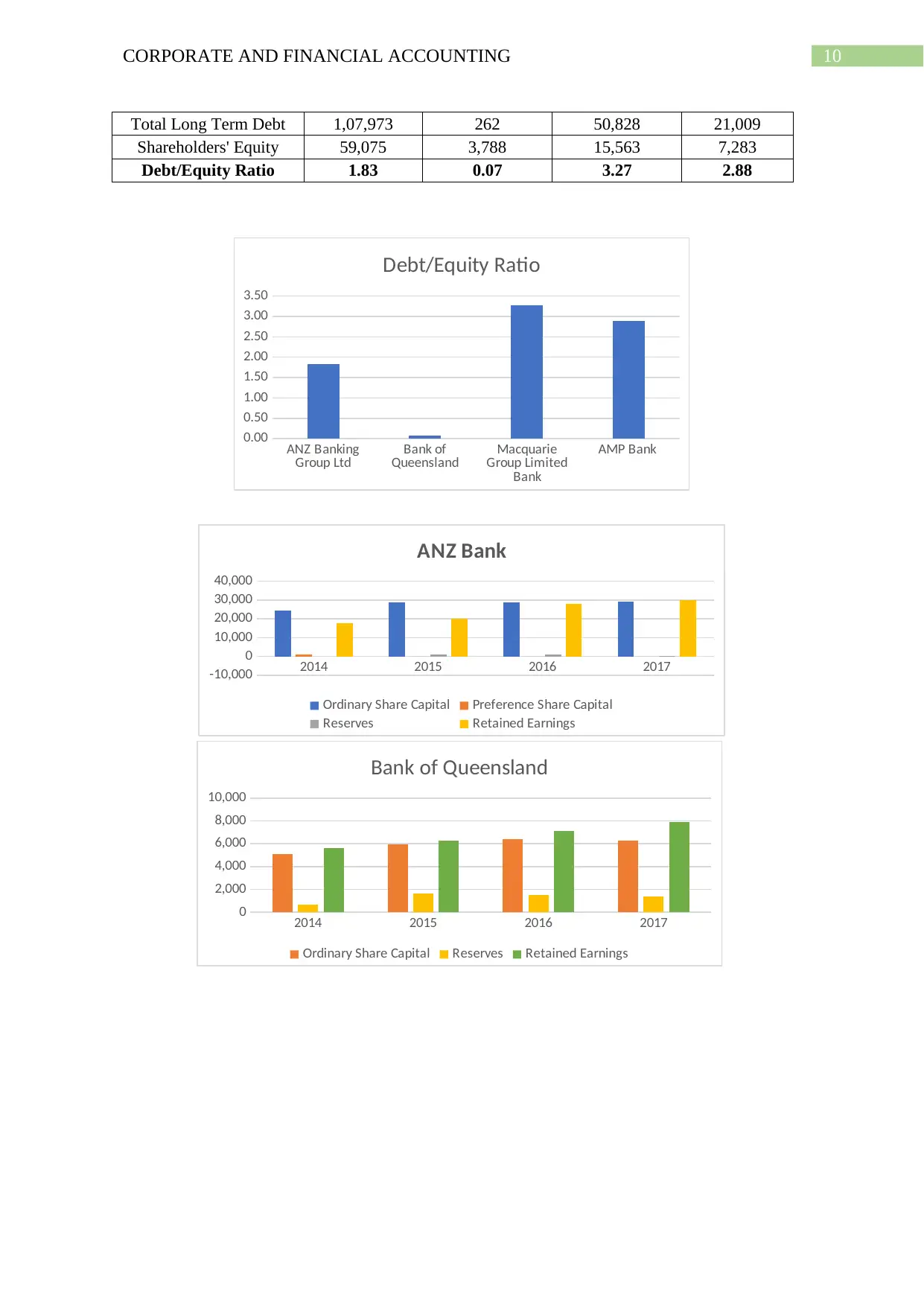
10CORPORATE AND FINANCIAL ACCOUNTING
Total Long Term Debt 1,07,973 262 50,828 21,009
Shareholders' Equity 59,075 3,788 15,563 7,283
Debt/Equity Ratio 1.83 0.07 3.27 2.88
ANZ Banking
Group Ltd Bank of
Queensland Macquarie
Group Limited
Bank
AMP Bank
0.00
0.50
1.00
1.50
2.00
2.50
3.00
3.50
Debt/Equity Ratio
2014 2015 2016 2017
-10,000
0
10,000
20,000
30,000
40,000
ANZ Bank
Ordinary Share Capital Preference Share Capital
Reserves Retained Earnings
2014 2015 2016 2017
0
2,000
4,000
6,000
8,000
10,000
Bank of Queensland
Ordinary Share Capital Reserves Retained Earnings
Total Long Term Debt 1,07,973 262 50,828 21,009
Shareholders' Equity 59,075 3,788 15,563 7,283
Debt/Equity Ratio 1.83 0.07 3.27 2.88
ANZ Banking
Group Ltd Bank of
Queensland Macquarie
Group Limited
Bank
AMP Bank
0.00
0.50
1.00
1.50
2.00
2.50
3.00
3.50
Debt/Equity Ratio
2014 2015 2016 2017
-10,000
0
10,000
20,000
30,000
40,000
ANZ Bank
Ordinary Share Capital Preference Share Capital
Reserves Retained Earnings
2014 2015 2016 2017
0
2,000
4,000
6,000
8,000
10,000
Bank of Queensland
Ordinary Share Capital Reserves Retained Earnings
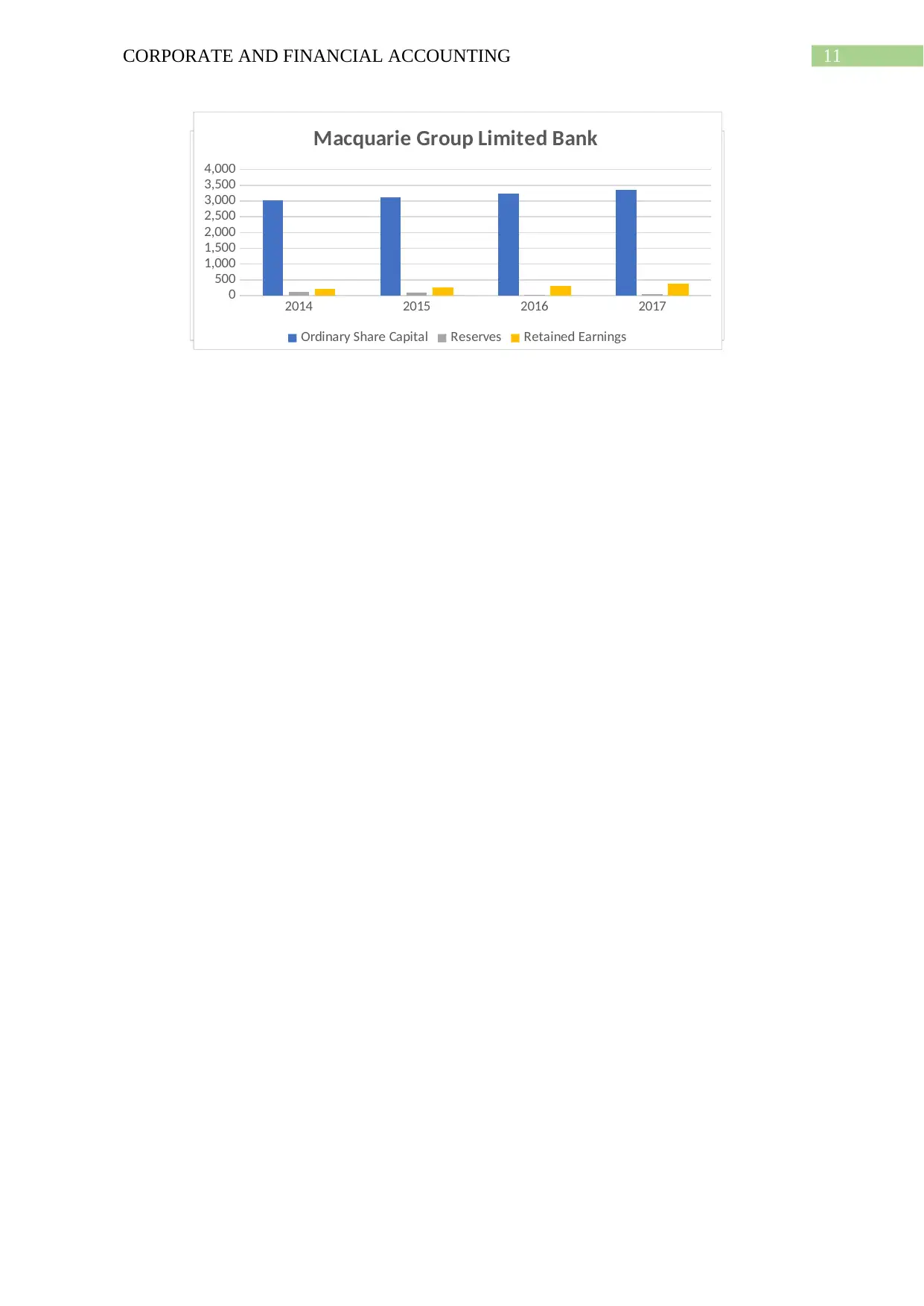
11CORPORATE AND FINANCIAL ACCOUNTING
2014 2015 2016 2017
-4,000
0
4,000
8,000
12,000
AMP Bank
Ordinary Share Capital Reserves Retained Earnings
2014 2015 2016 2017
0
500
1,000
1,500
2,000
2,500
3,000
3,500
4,000
Macquarie Group Limited Bank
Ordinary Share Capital Reserves Retained Earnings
2014 2015 2016 2017
-4,000
0
4,000
8,000
12,000
AMP Bank
Ordinary Share Capital Reserves Retained Earnings
2014 2015 2016 2017
0
500
1,000
1,500
2,000
2,500
3,000
3,500
4,000
Macquarie Group Limited Bank
Ordinary Share Capital Reserves Retained Earnings
⊘ This is a preview!⊘
Do you want full access?
Subscribe today to unlock all pages.

Trusted by 1+ million students worldwide
1 out of 15
Related Documents
Your All-in-One AI-Powered Toolkit for Academic Success.
+13062052269
info@desklib.com
Available 24*7 on WhatsApp / Email
![[object Object]](/_next/static/media/star-bottom.7253800d.svg)
Unlock your academic potential
Copyright © 2020–2025 A2Z Services. All Rights Reserved. Developed and managed by ZUCOL.



